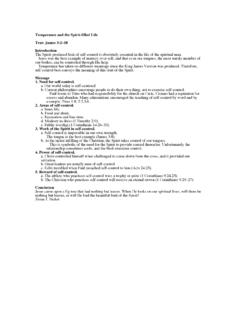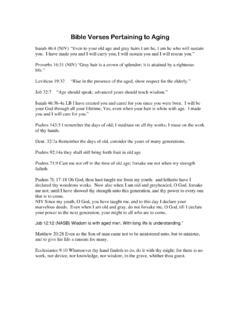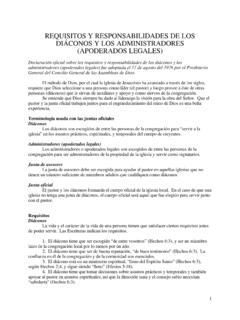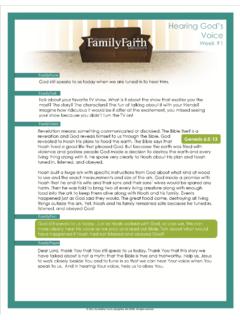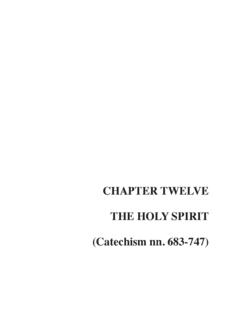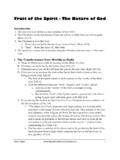Transcription of Not by Might nor by Power - AG
1 Not by Might nor by Power By: Stanley M. Horton This is the word of the Lord unto Zerubbabel, saying, Not by Might , nor by Power , but by my spirit , saith the Lord of hosts (Zechariah 4:6). Was this word a new departure? Did God mean He was now changing His method of working with men? Not at all. God s spirit was active in creation (Genesis 1:2) and has continued to be active at every stage of God s plan. Where God used armies, the victory was still the Lord s (Exodus 17:9 15). Even Samson s exploits were accomplished, not by superior muscle Power , but by the moving of the spirit of the Lord (Judges 13:25; 14:6; 15:14). Zechariah s vi-sion only draws attention to a fundamental principle that applies to all who are fellow laborers with the vision that brings this word is the fifth in a series of eight given to encourage those who were rebuilding the temple after its destruction by the Babylonians.
2 All eight are symbolic and all revolve around the work of the Messiah. God wanted the people to see their work for Him was not a matter of isolated, local events. What they were doing was part of the great plan of God for the redemption of the world, a plan that would find its consummation in the work of the Redeemer, our Lord Jesus Christ. A brief survey of these visions will help us see the fifth vision in its proper context. The first vision is of a company of horsemen among myrtle trees in a deep valley (perhaps suggesting the lowliness and the security of God s people). They are led by One on a red horse, One who is more than either man or angel, One who is Christ revealed as the Protector and Restorer of His people.
3 The second vision pictures four horns or world powers (probably the same ones represented by the image of Daniel 2 and the beasts of Daniel 7: Babylon, Medo-Persia, Greece, and Rome),1 and four smiths representing the world powers which in turn bring God s judgment on third vision presents a surveyor (Christ) with a measuring line, indicating that through Christ will come the fulfill-ment of God s promises of enlargement, peace, and glory for Jerusalem. The fourth vision pictures Joshua (Jeshua, Hebrew for Jesus), the current high priest (Ezra 2:2; 3:2), clothed in filthy garments representing the sins of the people. Though the adversary accuses him, the filthy garments are taken away, the sin is forgiven, and clean, beautiful garments are put upon him.
4 This is then declared to picture the work of the Mes-siah, the Branch, that is, the new shoot from the root of David (Isaiah 11:1; 53:1; Jeremiah 23:5). Significantly, the fifth vision emphasizing the spirit as the Giver of Power (Acts 1:8) follows immediately on this pic-ture of the forgiveness of sin. The remaining visions indicate that sinners must be destroyed, that sin must be removed, but that the agencies that will bring this about at the end of the age were, in Zechariah s day, being held in the fifth vision indicates a definite step beyond the fourth is suggested by the fact that the angelic messenger had to rouse Zechariah to a higher, more acute stage of spiritual consciousness in order to receive the vision, and also by the fact Zechariah finds the vision hard to (Note, Zechariah was not actually asleep.)
5 Many modern commen-tators seem to have just as much difficulty as Zechariah did, and there is much disagreement about the interpretation of vision itself is difficult to picture. Zechariah sees a solid gold candlestick or lampstand. (Tallow or wax candles were not used in Old Testament times.) The lampstand held seven lamps. We read that from the reservoir bowl at the top there were seven pipes to the seven lamps. Actually, the Hebrew reads seven seven pipes to the lamps. This has been interpreted as one pipe to each lamp, seven in all;5 two pipes to each lamp, 14 in all; or seven pipes to each lamp, 49 in all. The phrase seven seven according to Hebrew usage is best taken distributively, and most com-mentators who take it this way see in the seven pipes to each of the seven lamps a symbol of fulness of The Bible does not say how the lamps are arranged, however.
6 The lamps were probably not in a line as they were in the lampstand in Herod s Temple. More likely, they were in a circle under the bowl on arms of equal length branching at regular intervals from the central shaft. 7 Thus, the lamps would give light in all beauty of the golden lampstand is marred, however, by the concept of seven pipes to each lamp. The word pipe (Hebrew, mutsakah) actually means a place for pouring, a lip, or a spout. Archaeological discoveries show that Old Testament lamps were simple. They were just small, shallow, shell-shaped bowls with a lip pinched into one side where the wick was placed. I would suggest that the Hebrew phrase seven seven means the large reservoir bowl at the top had seven lips.
7 From these a continuous supply of oil poured into the lamps that were so arranged that one lamp was underneath each of these lips. Then, the distributive sense would also apply to the lamps so each lamp had seven lips for wicks, giving 49 lights in all. Thus, it would picture not only fullness of supply but a fullness of light spreading to all the world. This ties directly with Acts 1:8 and Matthew 24:14. The light of the gospel must continue to spread by the Power of the spirit toward the uttermost part of the world until the end of the age. Clearly, the oil is a type of the Holy spirit and the lamps are a type of those through whom the spirit gives light to the There is, however, little agreement among commentators concerning what the lampstand represents.
8 Some modern interpreters arbitrarily cut out the passage between verses 6a and 10b and make the seven lamps the seven eyes of This would make the lampstand represent God or Christ and the lamps symbols of the spirit . But this hardly fits the context,10 though Calvin took the lamps to represent the graces or the various gifts of His spirit , and the number seven to indicate Jewish commentators and most modern dispensationalists take the lampstand to be Israel or Israel restored dur-ing the millennium, since the Book of Revelation uses seven separate lampstands to represent the seven churches, and through them the Church as a , however, agree with Keil in taking the burning lamps as a symbol of the church or the nation of God which causes the light of its spirit or of its knowledge of God to shine before God and stream out into the night of a world estranged from God.
9 Recognizing that the New Testament often refers to disciples or the Church as lights (Matthew 5:14; Luke 12:35; Revelation 1:20).13 Or, better, as Leupold puts it: Every attentive reader can make his own ap-plication of this vision. The lampstand was the church of God as she gives light through the seven lamps, that is seven being the number of divine operation by the Power that God supplies. This Power is the spirit . A lamp fulfills its function when it shines in the Power of the fuel or oil that it has. The church fulfills her function, not by man s striving, but by letting the spirit make her a light to the world. At this point we are confronted by an issue of faith: will we believe that an adequate supply of the oil of the spirit will be provided by God?
10 This so manifestly leads to the motto: Not by Might , nor by Power . 14 But this is not all the picture. On each side of the lampstand is an olive tree with a golden pipe through which oil emp-ties. The word pipes (Hebrew, tsanteroth) in verse 12 is quite different from that in verse 2. Here, the meaning is a conduit. Yet, the Hebrew may be taken to mean that the oil in the bowl is supplied by the olive trees or that the oil in the bowl actually supplies the trees (called anointed ones, sons of oil, in verse 14) with their the latter case it may be taken as teaching that light is maintained by God, not by the prince, Zerubbabel, or his civil administration, and not by the priest, Joshua, or his religious establishment.
